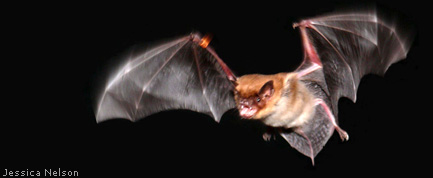Radar Could Save Bats from Wind Turbines

Bats use sonar to navigate and hunt. Many have been killed by wind turbines, however, which their sonar doesn't seem to recognize as a danger. Surprisingly, radar signals could help keep bats away from wind turbines, scientists have now discovered. Although wind power promises to be a clean source of energy, some researchers have raised concerns that wind turbines can inadvertently kill bats and other flying creatures. For instance, in 2004, over the course of six weeks, roughly 1,764 and 2,900 bats were killed at two wind farms in Pennsylvania and West Virginia, respectively. The bats might not be killed by the wind turbine blades directly, but instead by the sudden drop in air pressure the swinging rotors induce, which in turn cause their lungs to over-expand and burst surrounding blood vessels. "Given the growing number of wind turbines worldwide, this is going to be an increasing problem, no question about that," said researcher Paul Racey, a bat biologist at the University of Aberdeen in Scotland. Scientists have tried keeping birds from colliding into wind turbines by making their rotors easier to see. And to discourage bats away from wind farms, researchers have tried white noise generators as deterrents. However, these "acoustic scarecrows" have not worked well, Racey said, probably because these sound systems are not strong enough to influence bats within the entire space that rotors sweep through. A student at the University of Aberdeen first noticed that bats shied away from radar installations while driving past them. He was holding a bat detector out the window to scope out bat activity on the drive back home from out in the field. (Bat detectors are gadgets that scan for ultrasonic bat calls.) Although bats use sound waves to steer in the dark by echolocation, radar employs radio waves, a form of light, so one might at first assume that radar would have no effect on bats. To see if radar could keep bats away from wind turbines, the scientists at the University of Aberdeen installed small portable marine radar units at 20 bat foraging sites in Scotland — woodland and riverbank areas where insect densities are high. The researchers monitored bat presence for 58 nights using bat detectors. The researchers discovered that radar helped keep bats away, reducing bat activity by 30 to 40 percent. The radar did not keep insects away, which suggests that however the radar works as a deterrent, it does so by influencing the bats directly and not just their food. So how does radar keep bats away? The researchers explained that a great deal of research suggests that people can actually hear radar pulses. "This was noticed when radar arrays first started up during World War II," Racey said. "A portion of radar operators said they heard clicks in their ears when they were switched on." Radar signals can lead to small but rapid spikes of heat in the head that generate sound waves, which in turn stimulate the ear. "A bat's hearing is much more sensitive than ours," Racey noted. "It may be so sensitive that even a tiny amount of sound caused by electromagnetic radiation is enough to drive them out of there." Future research can design a radar system optimized at deterring bats. "What we want is a system that can reduce bat activity by 80 to 90 percent," Racey said. The scientists detailed their findings online July 16 in the journal PLoS ONE.
- Amazing Animal Abilities
- Video: All About Wind Power
- Amazing Things You Didn't Know About Animals
Get the world’s most fascinating discoveries delivered straight to your inbox.



